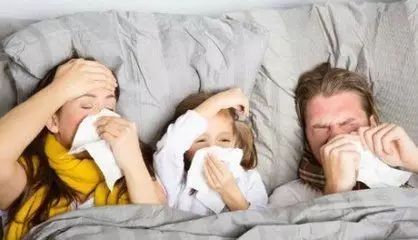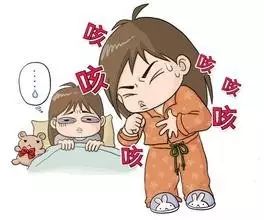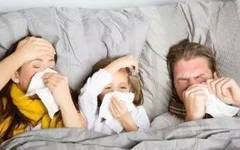In Traditional Chinese Medicine (TCM), the occurrence of a cold is attributed to the invasion of external pathogens, primarily wind. When there are abnormal climatic conditions, imbalances in temperature, or a deficiency in the body’s resistance, wind can wreak havoc. Mild colds are generally referred to as “wind colds.” In addition to wind, other external pathogens such as cold, heat, dampness, and summer heat can also invade the body, leading to varied symptoms of colds. After the weather cools down, wind-cold and wind-heat colds are the two most common types.

1. Wind-Cold Cold
When external pathogens invade the body, they typically enter through the skin and respiratory tract, reaching the lungs. Cold pathogens affect the surface of the body, causing individuals to feel cold and desire to wear more clothing. Additionally, sneezing, a runny nose with clear discharge, and a scratchy throat are common early symptoms of a wind-cold cold. Cold pathogens have a “constricting” characteristic, leading to symptoms such as absence of sweating, headaches, and even aches in the limbs. When external pathogens invade, the body mobilizes its “zheng qi” (正气, vital energy) to counteract them, which can result in fever. Therefore, during a wind-cold cold, individuals may feel cold while also experiencing fever. If the lungs are affected, symptoms may include coughing and phlegm production, with the phlegm typically being clear and thin.
To address the symptoms of wind-cold invasion, treatment focuses on warming and dispersing the exterior, as well as relieving cough and clearing the lungs, with medication selected based on the main accompanying symptoms.
In TCM formulas, for the initial onset of a cold, Zheng Chai Hu Yin (Zheng Chai Hu Decoction) granules can be used; for significant headaches, Chuan Xiong Cha Tiao (Chuan Xiong Tea Tiao) granules are recommended; for predominant symptoms of headache, limb aches, and general discomfort, Jiu Wei Qiang Huo (Nine Flavor Qiang Huo) granules can be used; for pronounced fever and headache, Gan Mao Qing Re (Cold and Flu Heat Clearing) granules are suitable; and for cough with phlegm, Jing Fang (Jing Fang Decoction) granules are recommended.
2. Wind-Heat Cold
In contrast to wind-cold, when wind-heat invades, the pores are open, leading to symptoms such as fever, sweating, and aversion to wind. Other symptoms may include a red and swollen throat, mild thirst, cough, and thick, sticky phlegm. It is important to note that some individuals who initially present with wind-cold symptoms may develop wind-heat symptoms after 3-5 days, necessitating an adjustment in treatment.
For wind-heat colds, the primary treatment methods involve cooling and dispersing the exterior, as well as clearing heat and soothing the lungs. Suitable medications include Yin Qiao Jie Du Pian (Yin Qiao Detoxification Tablets), Ling Yang Gan Mao Pian (Antelope Cold Tablets), and Ling Qiao Jie Du Pian (Ling Qiao Detoxification Tablets); for cases where fever is mild but cough is predominant, Sang Ju Gan Mao Pian (Mulberry and Chrysanthemum Cold Tablets) can be used; for significant fever, Chai Hu Kou Fu Ye (Chai Hu Oral Liquid) is recommended; and for fever, cough, and throat pain, Shuang Huang Lian Kou Fu Ye (Shuang Huang Lian Oral Liquid) is suitable. Additionally, Ban Lan Gen (Isatis Root) granules can be used as a preventive measure against wind-heat colds.
Although colds are common, if symptoms such as cough and phlegm worsen, accompanied by chest pain, or if symptoms persist for more than a week without improvement, or if body temperature exceeds 38.5 degrees Celsius, one should be cautious of secondary pneumonia and seek medical attention promptly.

Differences Between Wind-Cold and Wind-Heat Colds:
1. Sweating: No sweating indicates wind-cold; sweating indicates wind-heat.
Wind-cold cold: No sweating, symptoms include fever (high fever), headache, joint pain, and body aches.
Wind-heat cold: Sweating, symptoms include fever (not very high), sweating, aversion to wind, and aversion to cold.
2. Phlegm: Clear and thin indicates wind-cold; thick and turbid indicates wind-heat.
Clear and thin phlegm generally indicates wind-cold, while thick and turbid phlegm generally indicates wind-heat.
3. Nasal discharge: Clear discharge indicates wind-cold; yellow discharge indicates wind-heat.
Common Misconceptions in Cold Prevention and Treatment
Misconception 1: Believing that receiving the flu vaccine can prevent colds.
The flu vaccine is designed to protect against the influenza virus and is ineffective in preventing the common cold. Although both are respiratory infections, the pathogens differ, and the clinical symptoms vary, leading to different prevention and treatment methods. The common cold can occur year-round, typically presenting as sporadic cases without early fever. Influenza often occurs in late autumn or winter, caused by the influenza virus, characterized by its epidemic nature, transmitted through airborne droplets, and can lead to regional, national, or even global pandemics. The prominent symptoms include sudden onset, chills, high fever, and widespread muscle aches, with a high incidence of secondary bacterial infections in the respiratory tract.
Misconception 2: Believing that simply closing windows and covering oneself to sweat will cure a cold.
This is merely an illusion, as sweating may provide temporary relief, but it does not shorten the duration of the illness or lead to recovery. When a person has a cold, their appetite decreases, and their constitution weakens. Excessive sweating can easily lead to dehydration and collapse, further weakening the body’s resistance and worsening the condition. Cold patients should pay attention to keeping warm while ensuring good air circulation in their living spaces and should drink plenty of boiled water to replenish fluids and eliminate toxins from the body.
Misconception 3: Believing that one should avoid certain foods like eggs or milk during a cold.
Colds can reduce appetite, and symptoms like runny nose, cough, and fever increase energy consumption. If energy is not replenished through nutrition, the duration of the illness may be prolonged. Therefore, during a cold, it is important to consume easily digestible foods with a light flavor, and to include adequate protein, vitamins, and trace elements, such as lean meats, fish, eggs, vegetables, and fruits, to aid recovery.
Misconception 4: Believing that using multiple medications such as antibiotics, antipyretics, TCM formulas, and vitamins simultaneously will speed up recovery.
The common cold is mostly caused by viral infections, and antibiotics are ineffective against viruses. Moreover, misuse can lead to adverse drug reactions. Most medications for colds are compound preparations that often contain antipyretics. If various types are taken together, it may lead to drug overdose. For example, the maximum daily dose of acetaminophen (paracetamol) for adults should not exceed 2 grams, and taking more than one preparation containing this drug can result in overdose.
Misconception 5: Believing that a cold is a minor issue and continuing to work while sick.
Medical practice has shown that reduced sleep, excessive fatigue, and cold exposure can lower the body’s resistance, allowing bacteria and viruses to invade and cause illness. Especially after a cold, neglecting rest can lead to pathogens invading other parts of the body, resulting in secondary infections such as purulent tonsillitis, purulent sinusitis, bacterial bronchitis, and in some cases, pneumonia, myocarditis, or nephritis. This is particularly dangerous for the elderly and those with chronic diseases, as it can exacerbate chronic conditions such as chronic bronchitis, asthma, heart disease, kidney disease, and cancer, potentially threatening life. Therefore, sleep and rest are effective methods for restoring health and shortening the duration of illness. Additionally, many cold medications contain diphenhydramine (Dimenhydrinate), which can cause drowsiness, making it difficult for patients to continue working.

Preventing Colds: The “Three Cleans” Approach
Washing hands frequently, supplementing with vitamins and nutrients, getting adequate rest, and drinking plenty of water are well-known common sense for cold prevention. However, according to a recent article in Health magazine, Dr. D.C. Rona, a natural health expert in the U.S., proposed the lesser-known “Three Cleans” method for preventing colds.
1. Clean the Sinuses. The sinuses are the body’s first “filter” in the respiratory system. Well-functioning sinuses are the best barrier against cold viruses. It is recommended to rinse the nasal cavity and sinuses with saline daily, which is crucial for preventing colds and flu.
2. Clean the Hair. Hair, eyebrows, and facial hair can easily collect dust and other small particles, which can easily spread cold and flu viruses. If hair is not washed before bed, these particles can fall onto the pillow and subsequently enter the body through the eyes, nose, or mouth, increasing the risk of catching a cold. It is recommended to wash hair and bathe before bed.
3. Clean the Bedroom. First, ensure that bedding, sheets, and pillowcases are clean and comfortable. Secondly, ensure that the air in the bedroom is clean.



